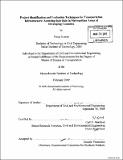Project identification and evaluation techniques for transportation infrastructure : assessing their role in metropolitan areas of developing countries
Author(s)
Kumar, Vimal, S.M. Massachusetts Institute of Technology
DownloadFull printable version (16.14Mb)
Other Contributors
Massachusetts Institute of Technology. Dept. of Civil and Environmental Engineering.
Advisor
Carl D. Martland.
Terms of use
Metadata
Show full item recordAbstract
Project identification and evaluation of transportation infrastructure play a vital role in shaping and sustaining the forms of cities all over the world. These cities differ substantially in character and urban form and have different transport systems and transport related problems. Most large cities in the developing world face major problems as a result of rapid population growth, extensive urbanization, market uncertainties, scarcity of resources and inadequate planning capabilities. Transport policies and procedures that worked reasonably well when cities were smaller start failing as they expand, while environmental and social problems become more pressing. The traditional methodologies for evaluating urban transportation infrastructure projects are unable to address issues of most concern in developing countries. The thesis outlines a framework for assessing the role of various planning and evaluation methodologies for transportation infrastructure projects. The framework developed for project identification and evaluation serves as a useful tool to structure and assess the gaps identified from a literature review and case studies. The major gaps identified can be listed as: * Lack of integrated approach for transportation infrastructure and land-use planning; * Inadequate provision for maintenance and monitoring of transport facilities; * Unequal distribution of benefits of transport for women; * Limited rural transport infrastructure; and * Lack of suitable financing arrangements and no incorporation of sustainable development measures. The overall transportation planning and evaluation process can be improved by incorporating certain steps and requirements that address these gaps and make transportation infrastructure more accessible, safer, reliable, and efficient.
Description
Thesis (S.M.)--Massachusetts Institute of Technology, Dept. of Civil and Environmental Engineering, 2009. Includes bibliographical references (p. 179-186).
Date issued
2009Department
Massachusetts Institute of Technology. Department of Civil and Environmental EngineeringPublisher
Massachusetts Institute of Technology
Keywords
Civil and Environmental Engineering.